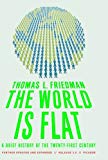
The World Is Flat is a book by Thomas Friedman discussing the trends of globalization in the 21st century. Friedman describes himself as a "free-trader," arguing in favor of the rapid shifts towards a more interconnected economic world after the fall of the USSR as a result of the Internet, computers, outsourcing and workflow software. Friedman also presents his controversial Dell Theory of Conflict Prevention: that corporations' increased dependency on foreign labor and resources will prevent armed conflict.
We see the Chinese manufacture of statuettes of The Virgin of Guadalupe and their subsequent importation into Mexico as an example of the problem created when one developing country competes with another, as China replaced Mexico as the U.S.’s number two importer in 2003. Friedman discusses the need for developing countries to put policies in place to create the right environment for their companies and entrepreneurs to succeed in the flat world. He states that countries must be brutally honest with themselves in determining their place in the world market if they are to adapt and survive. A comparison of countries who have opened their borders and adopted free trade policies versus those who have not and been left behind illustrates his point.
The concept of reform retail and wholesale is introduced as we explore changes in education, infrastructure and governance. Ireland becomes a case study for financial success as their per capita GDP has risen to second highest in the European Union. Friedman contemplates a society’s ability and willingness to sacrifice for the purpose of economic development and leaders with vision as vehicles of change and conversely, the reason some countries will not.
Already have an account? Log In Now